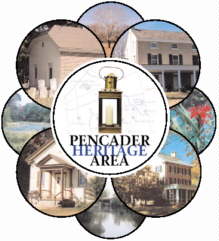 Probably the most unique feature of the Cooch House is the fact that a member of the Cooch family has occupied it for seven generations. The first two stories of the house were built in 1760 by Thomas Cooch and it may well be the oldest house in Delaware having the same family name. The land on which it stands has been in the family for 254 years. Thomas Cooch's great grandson, Levi Griffith Cooch, added a third story and rear wing around 1865. The house is safely situated on a rise facing east
towards the Christina River, approximately 150 feet away. To the north of the house is a smokehouse or springhouse
built of stone in the late 1700s. At the entrance to the drive leading to the house from Old Baltimore Pike is a Revolutionary War monument commemorating the Battle of Cooch's Bridge, erected by the Patriotic Societies and Citizens of Delaware. It was dedicated September 3, 1901 and consists of a granite marker surrounded by four cannons.
Probably the most unique feature of the Cooch House is the fact that a member of the Cooch family has occupied it for seven generations. The first two stories of the house were built in 1760 by Thomas Cooch and it may well be the oldest house in Delaware having the same family name. The land on which it stands has been in the family for 254 years. Thomas Cooch's great grandson, Levi Griffith Cooch, added a third story and rear wing around 1865. The house is safely situated on a rise facing east
towards the Christina River, approximately 150 feet away. To the north of the house is a smokehouse or springhouse
built of stone in the late 1700s. At the entrance to the drive leading to the house from Old Baltimore Pike is a Revolutionary War monument commemorating the Battle of Cooch's Bridge, erected by the Patriotic Societies and Citizens of Delaware. It was dedicated September 3, 1901 and consists of a granite marker surrounded by four cannons.
The British commander Lord Cornwallis occupied the Cooch house as his headquarters (according to the Cooch family his horse was occupying the parlor) until the army resumed its advance toward Philadelphia on September 8, 1777. At the request of General Washington the mill stone was removed to prevent the British from making flour, which may have prompted Cornwallis to order his men to burn the mill.
Just a few feet to the east of the monument is a bridge over the Christina River that carries the name of the Revolutionary battle
which is alleged to be the first place the Stars and Stripes were carried into battle. The current bridge, number 336, was built in
1922. Prior to that it was an iron bridge, erected in 1881. Before that a covered bridge built in 1846 spanned the stream. How many
bridges preceded it is unknown, but certainly the British crossed over a Cooch's Bridge in 1777 and the road was in existence for more than 100 years before that.
Thomas Cooch (the first generation Cooch in Pencader Hundred) was a miller and upon arriving from Hatfield, England in 1746 he purchased 200 acres containing a grist and saw mill. Thomas also started a family tradition that has lasted to this day- a tradition of proud service to the State of Delaware. When Delaware was preparing for the Revolution in 1775 a militia was organized in New
Castle and Thomas Cooch was elected Colonel for the lower half of the County. Prior to that he had served as a captain in the French and Indian War. By the time of his death in 1791 Thomas was the owner of more than 850 acres with not only the mills but an
ironworks. He had created a dynasty that is today the hub of the Pencader Historic Area. Two previous owners of the mills and
ironworks worth noting were Sir William Keith, the Governor of Pennsylvania and the Three Lower Counties, and John England.
The Cooch descendants are justifiably proud of their military, political and occupational service to Delaware and just as proud of
their ancestral bloodline. The family tree follows a path to five of the Colonial governors of New England, twelve of the Barons of
Runnimede and the Royal families of England, Scotland, and France to include Alfred the Great and William the Conqueror.
One passion that the Cooch family possesses, to the delight of historians, is their quest for the preservation of local history. Francis A. Cooch wrote Little Known History of Newark, Delaware and Its Environ's printed at the Press of Kells in 1936. Edward W. Cooch, Sr., Lieutenant-Governor of Delaware (1936-1940) authored; History of Iron Hill, The Folks of Welsh Tract, Pencader Chief Chair of Presbyterianism, Lafayette at Christiana, Valentine Hollingsworth and Newark Monthly Meeting, Delaware Historic Events 1946, The Battle of Cooch's Bridge 1940, and History of Hiram Lodge no. 25, A.F.&A.M., of Newark, Delaware'1945. The current inhabitant of the Cooch House is Edward W. Cooch Jr., who has been practicing law for 50 years and has his own law firm Cooch and Taylor. He has given countless talks on local history. His son Richard Rodney Cooch, who wrote A History of Christiana, Delaware published in 1976, is currently a Delaware Superior Court Judge.
|
